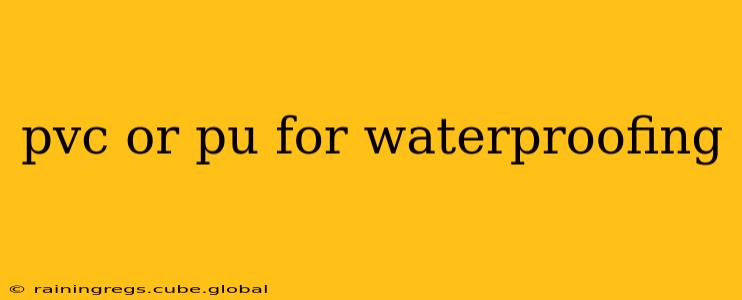Choosing the right waterproofing membrane is crucial for protecting your building or structure from water damage. Two popular choices are PVC (polyvinyl chloride) and PU (polyurethane) membranes. Both offer excellent waterproofing properties, but they differ significantly in their application, lifespan, and overall suitability for various projects. This guide will help you understand the key differences between PVC and PU membranes to make an informed decision.
What is PVC Waterproofing Membrane?
PVC waterproofing membranes are synthetic thermoplastic materials known for their durability and resistance to chemicals, UV radiation, and punctures. They are typically supplied as sheets or rolls and are welded together on-site to create a seamless waterproof barrier. PVC membranes are relatively easy to install and are a cost-effective option for many projects.
What is PU Waterproofing Membrane?
PU waterproofing membranes, on the other hand, are liquid-applied systems. They are sprayed or rolled onto the surface, forming a continuous, seamless membrane. PU membranes are highly flexible and can conform to complex shapes and surfaces, making them ideal for intricate projects. They are also known for their excellent adhesion and elongation properties.
PVC vs PU: Key Differences & Considerations
Here's a breakdown of the key differences between PVC and PU membranes, helping you determine which is the best fit for your needs.
Which is stronger?
Both PVC and PU membranes offer excellent strength, but their strength manifests differently. PVC membranes boast higher tensile strength, resisting tearing and punctures better. PU membranes excel in flexibility and elongation, allowing them to accommodate movement and expansion in the substrate. The "stronger" membrane depends on the specific demands of the project.
Which is more durable?
Durability depends on factors beyond the membrane itself, including proper installation and substrate conditions. Generally, both PVC and PU can offer long lifespans – upwards of 20-30 years with proper maintenance. However, PVC's resistance to punctures may give it a slight edge in certain applications. UV degradation is a factor for both, but appropriately formulated membranes mitigate this significantly.
Which is easier to install?
PVC membrane installation involves welding sheets together, requiring specialized equipment and expertise. This can be more time-consuming and labor-intensive. PU membranes, being liquid-applied, often require less specialized equipment and can be quicker to install for simpler projects, although complex projects may demand equal or more skill.
Which is more expensive?
The initial cost of PVC membranes is generally lower than PU membranes. However, the overall cost should consider factors like installation time, labor costs, and the longevity of the material. The long-term cost effectiveness needs careful analysis.
Which is better for different applications?
- Flat roofs: Both PVC and PU are suitable. PVC might be preferred for its puncture resistance if there's a risk of foot traffic or debris.
- Sloped roofs: Both can be used, but PU’s flexibility might be advantageous on complex slopes.
- Basements: PU’s ability to penetrate and seal cracks makes it a strong contender.
- Balconies and terraces: Both are viable options, with choice depending on the specific conditions and design requirements.
What are the advantages and disadvantages of PVC membranes?
Advantages:
- Relatively inexpensive
- Durable and resistant to punctures
- Easy to repair
- Available in various colors and thicknesses
Disadvantages:
- Less flexible than PU
- Can be difficult to install on complex surfaces
- Susceptible to UV degradation if not properly protected
What are the advantages and disadvantages of PU membranes?
Advantages:
- Highly flexible and conforms to complex shapes
- Excellent adhesion and waterproofing properties
- Seamless application, minimizing potential leak points
- Can bridge small cracks and imperfections
Disadvantages:
- More expensive than PVC
- Installation requires specialized equipment and training
- May be more susceptible to damage from sharp objects if not properly protected
Which is better for green roofs?
Both PVC and PU can be used on green roofs, but the choice depends on the specific requirements of the design. PU's flexibility could be beneficial for accommodating the movement of the growing media.
Which is better for swimming pools?
Both are suitable for swimming pools, but the choice often depends on specific project requirements and the pool's construction. Consult with a waterproofing specialist for recommendations tailored to your project.
Ultimately, the best choice between PVC and PU waterproofing membranes depends on the specific project requirements, budget, and desired lifespan. Consulting with a qualified waterproofing contractor is crucial to make the most informed decision. They can assess your project's unique conditions and recommend the best solution for lasting protection.
